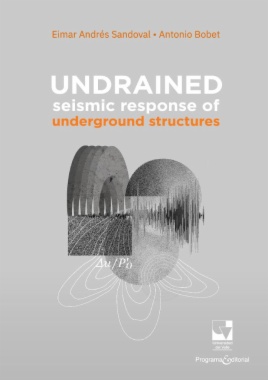Underground structures must be able to support static overburden loads, as well as to accommodate additional deformations imposed by seismic motions. It seems well established that the most critical demand to the structure is caused by shear waves traveling perpendicular to the tunnel axis, which cause distortions of the cross section (ovaling for a circular tunnel, and racking for a rectangular tunnel) that result in axial forces (thrusts) and bending moments. While all this has been well-studied for structures placed in linear-elastic ground under drained loading conditions, there is little information regarding the behavior of buried structures placed in nonlinear ground, especially under undrained loading conditions, i.e., when excess pore pressures generate and accumulate during the earthquake. This book includes results of two-dimensional dynamic numerical analyses conducted to assess the seismic response of deep circular tunnels located far from the seismic source, under drained or undrained loading conditions. It is assumed that the liner remains elastic and that plane strain conditions apply. A new cyclic elastoplastic constitutive model is proposed to predict the nonlinear behavior and the excess pore pressures in the ground. The effect of the input frequency on the tunnel distortions of the cross section, and the effect of the relative stiffness between the liner and the ground on the distortions of the cross section, as well as, on the axial forces and bending moments of the liner are investigated. Excess pore pressures, shear stresses and plastic strains in the ground for different relative stiffness are also investigated.
- Cover
- Title page
- Copyright page
- Contents
- 1 Introduction
- 1.1 Problem statement and motivation
- 1.2 Research objective and scope of the work
- 1.3 Outline
- 2 Background
- 2.1 Introduction
- 2.2 Effect of earthquakes on underground structures
- 2.2.1 Effect of ground shaking on underground structures
- 2.3 Reported damage to underground structures during seismic events
- 2.3.1 A history case: The Daikai Station collapse
- 2.4 Drained seismic response
- 2.4.1 Free field approach
- 2.4.2 Soil-structure interaction approach
- 2.5 Undrained seismic response
- 2.5.1 Bobet (2003, 2010)
- 2.5.2 Okhovat and Maekawa (2009)
- 2.6 Constitutive models
- 2.6.1 Commonly used models
- 2.7 Pore pressure models
- 2.7.1 Martin, Finn and Seed (1975)
- 2.7.2 Dobry, Pierce, Dyvik, Thomas and Ladd (1985)
- 2.7.3 Iv�si´c (2006)
- 2.8 Pore pressure generation in coarse-grained deposits
- 2.8.1 Numerical analyses
- 2.8.2 Cyclic large-size laboratory tests
- 2.9 Summary and discussion
- 3 Constitutive model
- 3.1 Introduction
- 3.2 The cyclic nonlinear elastoplastic model
- 3.2.1 Hyperbolic behavior
- 3.2.2 Cyclic loading
- 3.2.3 Update of the small-strain shear modulus (Go)
- 3.2.4 Coupled shear-volumetric strains with excess pore pres sures accumulation
- 3.2.5 Yield criterion and plastic strain
- 3.3 Implementation of the elastoplastic model in FLAC
- 3.3.1 Explicit, time-marching scheme
- 3.3.2 Lagrangian analysis
- 3.3.3 Mixed discretization scheme
- 3.3.4 Model implementation
- 3.4 Summary and discussion
- 4 Constitutive model verification
- 4.1 Introduction
- 4.2 Stage 1: stiffness degradation, comparison with 1-D codes andmonotonic test
- 4.2.1 Stiffness degradation under drained cyclic simple shear
- 4.2.2 Comparison with 1D codes
- 4.2.3 Verification of a drained monotonic test
- 4.3 Stage 2: Cyclic laboratory tests
- 4.3.1 Drained laboratory tests
- 4.3.2 Undrained laboratory tests
- 4.4 Simulation of laboratory tests using more elements
- 4.5 Stage 3: Large scale - centrifuge tests
- 4.5.1 Centrifuge test on saturated sand with excess pore pressures generation
- 4.5.2 Centrifuge modelling of a tunnel in dry sand
- 4.6 Summary and comments
- 5 Effect of input frequency on tunnel distortions
- 5.1 Introduction
- 5.2 Linear-elastic ground
- 5.3 Nonlinear elastoplastic ground under drained loading
- 5.4 Nonlinear elastoplastic ground under undrained loading without excess pore pressures accumulation
- 5.5 Nonlinear elastoplastic ground under undrained loading considering excess pore pressures accumulation
- 5.6 Summary and discussion
- 6 Seismic response of underground structures
- 6.1 Introduction
- 6.2 Linear-elastic analysis
- 6.2.1 Effect of relative stiffness on tunnel distortions
- 6.3 Nonlinear elastoplastic analysis for drained loading
- 6.3.1 Effect of relative stiffness on tunnel distortions
- 6.4 Nonlinear elastoplastic analysis for undrained loading without excess pore pressures accumulation
- 6.4.1 Excess pore pressures in the ground
- 6.4.2 Shear stresses in the ground
- 6.4.3 Effect of relative stiffness on tunnel distortions
- 6.4.4 Effect of relative stiffness on liner loading
- 6.5 Nonlinear elastoplastic analysis for undrained loading considering excess pore pressures accumulation
- 6.5.1 Excess pore pressures in the ground
- 6.5.2 Contours of shear stresses in the ground.
- 6.5.3 Contours of normalized shear modulus
- 6.5.4 Effect of relative stiffness on tunnel distortions
- 6.5.5 Effect of relative stiffness on liner loading
- 6.6 Seismic response using pseudo-static numerical analyses
- 6.7 Summary and discussion
- 7 Summary, conclusions and proposed futurework
- 7.1 Introduction
- 7.2 Summary of the work
- 7.2.1 Development of the constitutive model
- 7.2.2 Verification of the constitutive model
- 7.2.3 Effect of input frequency on tunnel distortions
- 7.2.4 Parametric study to evaluate the seismic response of tunnels
- 7.3 Conclusions
- 7.3.1 Performance criteria
- 7.4 Recommendations for future work
- References
- Index

